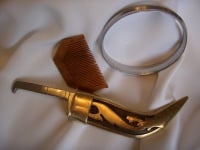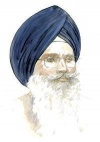Five ks
| Part of a series on Sikh Practices |
| Sikhism |
| Sanskar |
| Sikh rites |
| Personal 5 Banis . Five ks |
The Five Ks, or panj kakaar/kakke, are five items of faith that baptised Khalsa Sikhs wear at all times at the command of the tenth Sikh Guru, Guru Gobind Singh who so ordered at the Baisakhi Amrit Sanchar in 1699. The Five Ks are not merely symbols but articles of faith which collectively form the external visible symbols to identify and clearly and outwardly advertise and display ones commitment and dedication to the order (Hukam) of the tenth master. Guru Gobind Singh ordered his followers to wear the Five Ks so that they could actively use them to make a difference to their own and to others' spirituality. However, Sikhism recognises the concept of a multi-level approach to achieving one's target as a disciple of the faith as well. For example, "Sahajdhari" (slow adopters) are those Sikhs who have not yet donned the full Five Ks.
Note: In certain places where it is inappropriate to wear most of 5 K’s (Bathroom, shower, swimming), one can remove them to preserve and show respect for cleanliness of 5 Kakars but these must be readily available to the Sikh instantly.
the five k's
Kesh (uncut hair) relates to the element of ether
Kanga (wooden comb) relates to the element of earth
Kara (steel bracelet) relates to the element of air
Kachera (cotton underwear) relates to the element of water
Kirpan (sword) which relates to the element of fire.
Most male Sikhs will wear a Turban over the uncut hair or Kesh
Kesh
A Sikh never cuts or trims any hair (Kesh), to indicate the perfection of God's creation. The comb keeps the hair tidy, a symbol of not just accepting what God has given, but also an injunction to maintain it with grace. The Guru said hair should be allowed to grow naturally. For men, this includes not shaving. At the time of Guru Gobind Singh, some holy men let their hair become tangled and dirty. The Guru said that this was not right. Hair should be allowed to grow but it should be kept clean and combed at least twice a day.
- Main article: Kesh
Kanga
A Kanga is a small wooden comb that Sikhs use twice a day. It should be worn in the hair all the time. Combs help to clean hair and remove tangles from it, as well as being a symbol of cleanliness to the Sikhs. Combing their hair reminds them that their lives should be tidy and organized, too. The Sikhs were commanded by Guru Gobind Singh to wear a small comb called the Kanga at all times.
- Main article: Kanga
Kara
Kara means a link. It is a special iron bracelet which is worn on the wrist of the dominant hand. The Kara is the Guru's own symbolic ring to all his Sikhs signifying their unbreakable link with the Guru as well as among themselves. The circle is also a symbol of controlling feelings and practice as well as a constant reminder to the Sikh of complete behavior in the event of weakness.
- Main article: Kara
Kaccha
A Kacha or Kaccha is a pair of knee length shorts. This is a special, slightly longer type of underwear and is symbolic of continence and a high moral character. Like breeches, Kacha can be worn on their own without causing embarrassment. Thus it is quite useful in hot weather, swimming and sports activities.
- Main article: Kaccha
Kirpan
Kirpan comes from the word 'KIRPA' and 'AAN'. Kirpa means an act of kindness or a favour; 'aan' means honour, respect, and self-respect. It is an instrument which adds to self-respect and self-defence. Thus for Sikhs, Kirpan is the symbol of power and freedom of spirit. All baptised Sikhs should wear a short form of Kirpan (approx. 6" to 9" long) on their body. To call it a dagger or knife is rather insulting to this article of faith, which functions quite differently from the other two. The blade should be made of iron.
A Sikh should never use the Kirpan in anger or for a malicious attack. However, a Sikh may use it in self-defence or to protect a person in need. Some Sikhs choose to learn the art of Gatka. This is a martial art devised by the Sikh Gurus that uses circular movements to effectively swing a sword.
- Main article: Kirpan
See also
- The Amrit Sanskar ceremony
- Vaisakhi
External links
- The Sikh Symbols - eBook
- The Sikh Bangle (Karra) - eBook
| These articles deal with Sikh's Five ks |
|
Kesh (uncut hair) -|- Kara (bangle) -|- Kanga (small comb) -|- Kachera (under garment) -|- Kirpan (sword) |
| Gurus: | Nanak Dev | Guru Angad | Amar Das | Ram Das | Guru Arjan | Har Gobind | Har Rai | Har Krishan | Tegh Bahadur | Gobind Singh | Guru Granth Sahib | Sikh Bhagats |
| Philosophy: | Sikh Beliefs | Simran | Sewa | Beliefs and Principles | Underlying Values | Prohibitions | Technique and Methods | Other observations | Technique and Methods |
| Practices: | Ardas | Amrit Sanskar | Chardi Kala | Dasvandh | Five Ks | Kirat Karni | Kirtan | Langar | Naam Japna | Simran | Three Pillars | Vand Chakna | Five Evils | Five Virtues |
| Scripture: | Guru Granth Sahib | Sikh Scripture | Dasam Granth | Ek Onkar | Waheguru | Bani | Mool Mantar | Japji Sahib | Jaap Sahib | Chaupai | Anand Sahib | Tav-Prasad Savaiye | Rehras | Sukhmani |
| More: | History | Gurdwaras | Harmandir Sahib | Khalsa | Khanda | Names | Places | News | Satguru | Sikhs | Bhagat Farid | Bhagat Kabir | Websites | Biographical | Terms |







